Tokyo Districts and Shopping Areas
Shinjuku
Shinjuku is one of the 23 wards of the metropolis of Tokyo, but commonly refers to just the large entertainment, business and shopping area around Shinjuku Station.
Handling more than two million passengers each day, Shinjuku Station is Japan's busiest railway station, served by six railway companies and about a dozen railway and subway lines, including the JR Yamanote Line.
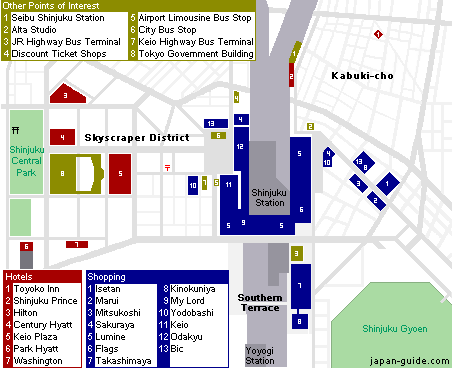
Shibuya
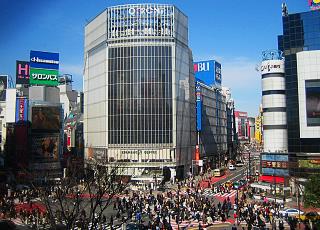
Shibuya is one of the twenty-three city wards of Tokyo, but often refers to just the popular shopping and entertainment area around Shibuya Station.
Shibuya is one of Tokyo's most colorful and busy districts and birthplace to many of Japan's fashion and entertainment trends. Most of the area's large department and fashion stores belong to either Tokyu or Seibu, two competing corporations.
A prominent landmark of Shibuya is the large intersection in front of the station (Hachiko Exit), which is heavily decorated by neon advertisements and giant video screens and gets crossed by amazingly large crowds of pedestrians each time the traffic light turns green.
Below is a map and list of some of Shibuya's other major attractions:
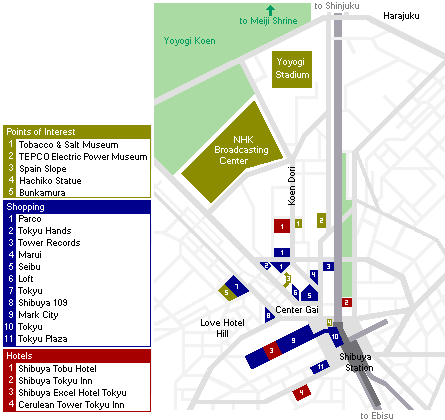
Harajuku
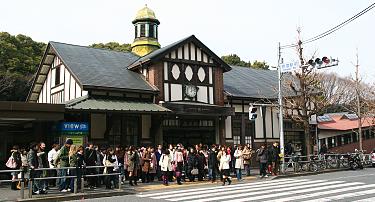
Harajuku refers to the area around Tokyo's Harajuku Station, one station north of Shibuya on the Yamanote Line. It is the center of Japan's most extreme teenage cultures and fashion styles, but also offers shopping for grown-ups and some historic sights.
The focal point of Harajuku's teenage culture is Takeshita Dori (Takeshita Street) and its side streets, which are lined by many trendy shops, fashion boutiques, used clothes stores, crepe stands and fast food outlets geared towards the fashion and trend conscious teens.
In order to experience the teenage culture at its most extreme, visit Harajuku on a Sunday, when many young people gather around Harajuku Station and engage in cosplay ("costume play"), dressed up in crazy costumes to resemble anime characters, punk musicians, etc.
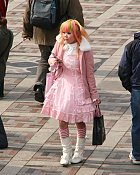 | 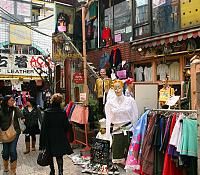 | 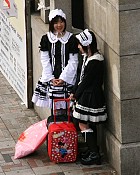 |
Shops, cafes and restaurants for all ages are found along Omotesando, a broad, tree lined avenue, sometimes referred to as Tokyo's Champs-Elysees. Omotesando Hills, a recently opened shopping complex along the avenue, has been attracting particularly lots of attention.
However, Harajuku is not only about teenage culture and shopping. Meiji Shrine, one of Tokyo's major shrines, is located just west of the railway tracks in a large green oasis shared with Yoyogi Park, a spacious public park. Beautiful ukiyo-e paintings are exhibited in the small Ota Memorial Museum of Art.
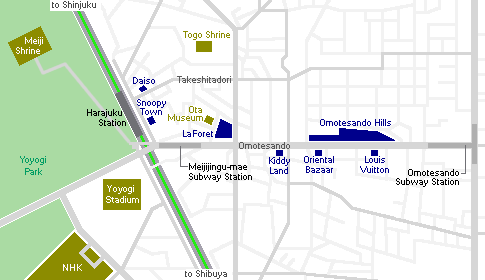
Asakusa
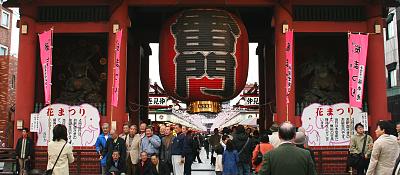
Asakusa is the center of Tokyo's shitamachi, lit. "low city", one of Tokyo's few districts, which have preserved a certain atmosphere of the old Tokyo.
Asakusa's main attraction is Sensoji, a very popular Buddhist temple, built in the 7th century. The temple is approached via the Nakamise, a shopping street that has been providing temple visitors with a variety of traditional, local snacks and tourist souvenirs for centuries.
Asakusa can be easily explored on foot. Alternatively, you can consider a guided tour on a rickshaw (jinrikisha, lit. "man powered vehicle"). A 30 minute tour for two persons costs around 8000 Yen. Shorter and longer courses are also available.
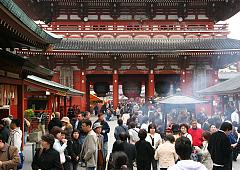 | 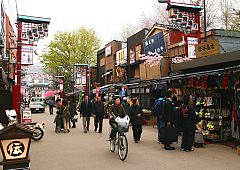 |
For many centuries, Asakusa used to be Tokyo's leading entertainment district. During the Edo Period, when the district was still located outside the city limits, Asakusa was the site of kabuki theaters and a large red light district. In the late 1800s and early 1900s, modern types of entertainment, including movies, set foot in Asakusa.
Large parts of Asakusa were destroyed in the air raids of World War Two. While the area around the rebuilt Sensoji has regained its former popularity after the war, the same cannot be said for Asakusa's entertainment district.

Odaiba
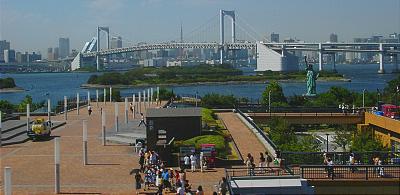
Daiba, literally meaning "fort", refers to some of the man made islands in the Bay of Tokyo, which were constructed in the end of the Edo Period (1603-1868) for the city's protection against attacks from the sea.
During the extravagant 1980s, a spectacular redevelopment of the islands into a futuristic business district was started, but development was critically slowed down after the burst of the "bubble economy" in the early 1990s.
It was not until the second half of the 1990s, that Odaiba developed into one of Tokyo's most interesting tourist spots and the highly popular shopping and entertainment district, which it is today. Further development of the area is still underway.
Among the attractions of Odaiba are several shopping and entertainment centers, theme parks, museums and the futuristic architecture and city planning. Even access to Odaiba can be considered an attraction.
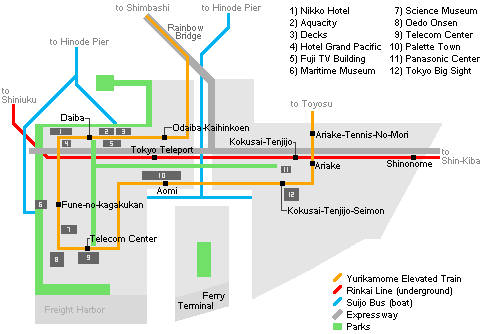
Ginza
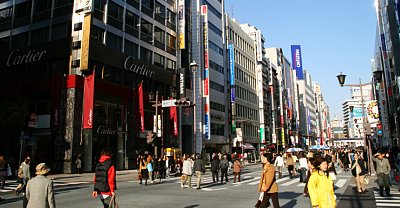
The Ginza is Tokyo's most famous upmarket shopping, dining and entertainment district, featuring numerous department stores, boutiques, art galleries, restaurants, night clubs and cafes.
One square meter of land in the district's center is worth more than ten million yen (more than 100,000 US dollars), making it one of the most expensive real estate in Japan. It is where you can find the infamous $10 cups of coffee and where virtually every leading brand name in fashion and cosmetics has a presence.
From 1612 to 1800, today's Ginza district was the site of a silver coin mint (Japanese: ginza), after which the district was eventually named. The Ginza evolved as an upmarket shopping district following the 1923 Great Kanto Earthquake.
A visit to the Ginza is most pleasant on a weekend afternoon, when the central Chuo Dori gets closed to traffic and become a large pedestrian zone. The closure takes place from 14:00 to 17:00 on Saturdays and from 12:00 to 17:00 on Sundays (until 18:00 from April through September).
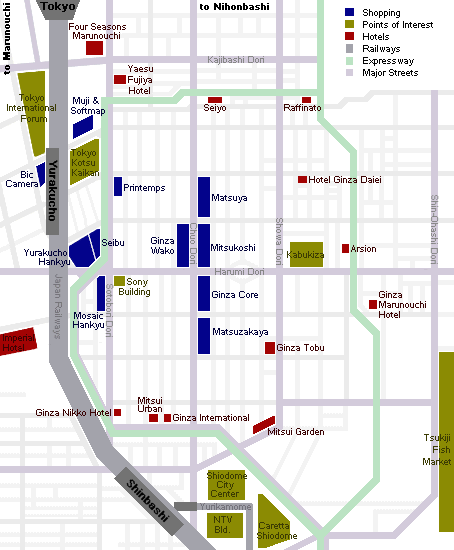
Akihabara
Akihabara (short: Akiba) is a district in central Tokyo, famous for its many electronics shops. In recent years, it has also gained fame as a center of the gaming, manga and animation culture. A major redevelopment of Akihabara Station and surroundings is nearing its completion, giving Akihabara a new face.
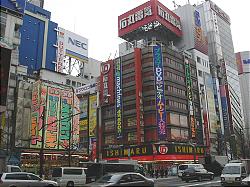 | 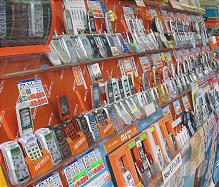 |
Electronics
Hundreds of electronics shops of various sizes can be found around Akihabara Station and along Chuo Dori (Chuo Avenue). They offer everything from the newest computers, cameras, televisions, mobile phones and home appliances to second-hand goods and electronic junk.
A few major stores, such as Ishimaru Denki, Sofmap and Laox operate multiple branch stores mainly along the main roads, while many smaller shops can be found in the narrow side streets.
Note that some of the electronic appliances on sale are only suited for use in Japan due to voltage and other technical differences and limited warranty. However, several stores also feature a selection of products for overseas use and offer duty free shopping to foreign tourists on purchases of over 10,000 Yen (passport required).
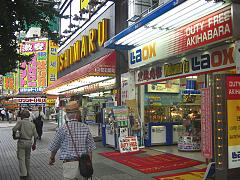 | 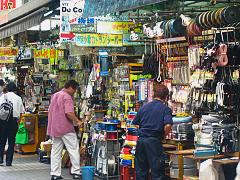 |
Manga, Animation and Games
The character of Akihabara has constantly changed over the decades and continues to do so. A recent development is the emergence of Akihabara as a center of Japanese animation culture, as the number of stores offering video games, manga and animation related goods has notably increased.
In addition to conventional stores, various other animation related establishments have appeared in the area, such as cosplay ("costume play") cafes, where waitresses are dressed up like anime characters, and manga kissaten ("comics cafes"), where customers can read comics, watch DVDs and surf the internet.
Redevelopment of Akihabara
A large scale redevelopment of the area north and east of Akihabara Station as well as of the station itself is nearing completion. The result are several new buildings such as the Akihabara Dai Building (opened in spring 2005), Akihabara UDX (opened in spring 2006) and Yodobashi Akiba Building (opened in autumn 2005).
Furthermore, Akihabara has been serving as the terminal station of the Tsukuba Express since August 2005. A brand new railway line, the Tsukuba Express connects central Tokyo with Tsukuba City in western Ibaraki Prefecture.
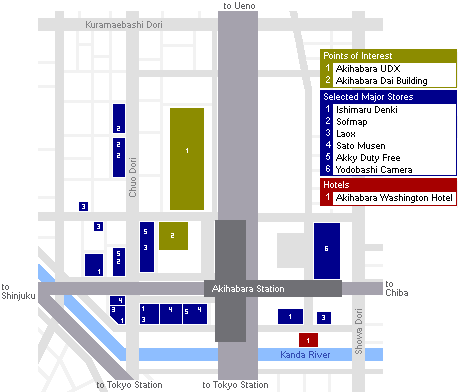
Marunouchi
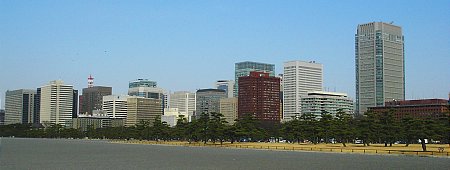
Situated between Tokyo Station and Tokyo Imperial Palace, Japan's most prestigious business district of Marunouchi with neighboring Otemachi, is home to the headquarters or Tokyo branches of many of Japan's largest companies, particularly from the financial sector.
Thanks to several, newly opened shopping and dining complexes around Tokyo Station, the formerly rather unexciting business district has started to draw an increasing number of business unrelated visitors in recent years. The main attractions are the recently opened Marubiru and Marunouchi Oazo.
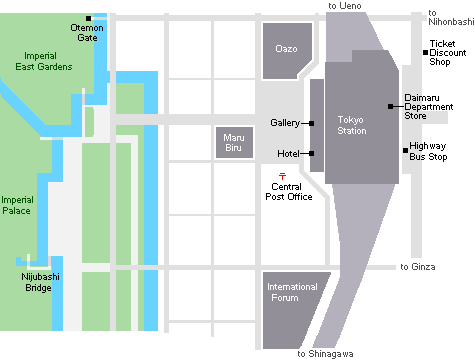
Nihonbashi
Nihonbashi, literally meaning "Japan Bridge", is a city district of Tokyo, just north of Ginza. The bridge, after which the district is named, has been the mile zero marker for Japan's national highway network since the early Edo Period.
Formerly a wooden bridge, the Nihonbashi was reconstructed in stone during the Meiji Period, and covered by an express way in the 1960s. You can cross a partial 1:1 replica of the original wooden bridge in the Edo-Tokyo Museum in Ryogoku.
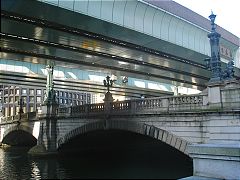 | 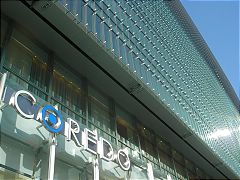 |
As the "center of Japan", the Nihonbashi district has enjoyed much commercial prosperity over the centuries. In the 1600s, the Mitsui family chose it as the site for their Edo branch of Echigoya, a highly successful wholesale business and predecessor of Japan's first Western style department store, the still existing Mitsukoshi Nihonbashi.
Continuing the tradition, Coredo Nihonbashi, a stylish shopping complex, topped by several floors of office space, was opened on March 30, 2004 in the very heart of Nihonbashi, giving the district fresh momentum. On five floors, Coredo Nihonbashi features trendy shops, cafes and restaurants, including a supermarket in the basement.
Nihonbashi Station on the Subway Ginza, Tozai and Asakusa Lines brings you into the very center of the Nihonbashi district.
Ikebukuro
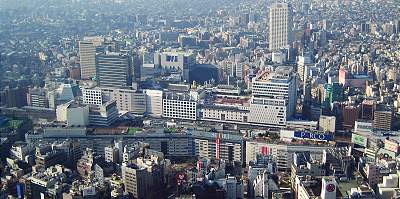
Ikebukuro is one of Tokyo's multiple city centers, located in the northwestern corner of the Yamanote loop line. Ikebukuro offers plenty of entertainment, shopping and dining opportunities.
Handling more than a million passengers per day, Ikebukuro Station is surpassed only by Shinjuku Station as Japan's busiest railway station. Three subway and multiple urban and suburban train lines commence or pass through the large station complex.
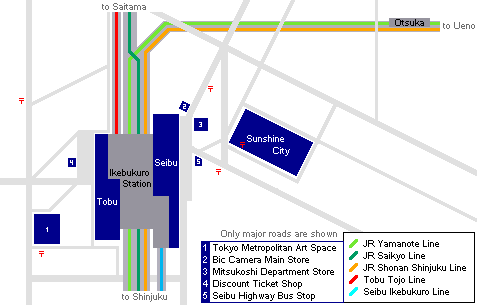
Tokyo Dome City
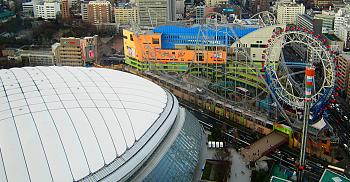
Tokyo Dome City is a leisure complex in central Tokyo consisting of the Tokyo Dome baseball stadium, an amusement park, the LaQua spa, a variety of shops and restaurants and Tokyo Dome Hotel.
The amusement complex used to be known as Korakuen, named after the former baseball stadium, which in turn was named after nearby Japanese landscape garden Koishikawa Korakuen.
Tokyo Dome City experienced a boost in popularity when LaQua, an indoor spa complex with real hot spring water, was opened in 2003.
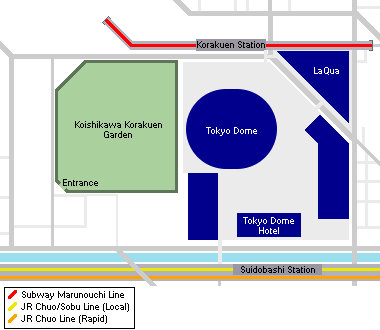
Roppongi Hills
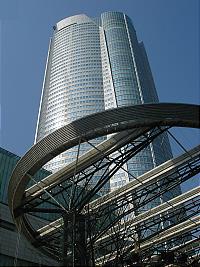
Opened in spring 2003, Roppongi Hills continues to be one of Tokyo's trendiest spots.
Roppongi Hills is a city within the city, an attractively redeveloped neighborhood in the district of Roppongi, consisting of residential, recreational and office space, an art museum, cinema complex, hotel and various shops, restaurants and cafes.
In the center of Roppongi Hills stands the Mori Tower, a 54-storey skyscraper named after the company and company president that built it.
The first six floors of the Mori Tower are occupied by shops and restaurants, while the top six floors house the Mori Art Center, including the Mori Art Museum, and the "Tokyo City View" observation deck with fine views of the city. Offices fill the 43 floors in between.
Adjacent to the Mori Tower stand a few more buildings filled mostly with shops and restaurants, as well as the luxury hotel Grand Hyatt Tokyo, a Virgin Cinemas complex and the Mori Garden, a modern version of a traditional Japanese landscape garden. Just next to the garden are the new headquarters of TV Asahi, one of Japan's nationwide television stations.
Behind the Mori Tower runs the Roppongi Keyakizaka Street which is lined by cafes and luxury brand shops such as Louis Vuitton. Across the street stand four residential high-rise buildings.
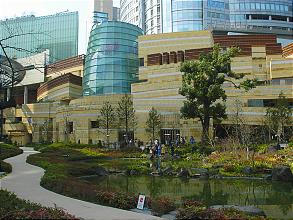 | 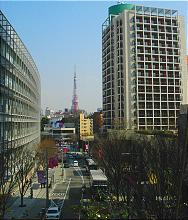 |
The closest subway station is Roppongi Station on the Oedo and Hibiya Line.
Shiodome
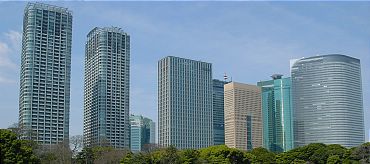
Shiodome Shiosite is one of Tokyo's newest cities within the city. Its spectacular skyscrapers accommodate many offices, the headquarters of Nippon Television and a large variety of shops, cafes, restaurants, theaters and hotels.
Shiodome used to be a marshy tideland in the beginning of the Edo Period (1603 - 1867), when it was reclaimed and given its present name, literally meaning "place where the tides stop".
In 1872, Shiodome became the site of Shimbashi Station, the Tokyo terminal of Japan's first railway line, connecting Tokyo with Yokohama. The station was later renamed Shiodome Station and converted into a large railway freight terminal, which it remained into the 1980s. The redevelopment of Shiodome started a few years later.
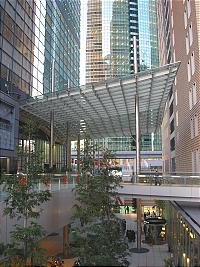
A replica of the former Shimbashi Station building is one of Shiodome's attractions. Standing next to the Shiodome City Center skyscraper, it houses a small museum about the history of the railway station and the Shiodome area with English explanations.
Caretta Shiodome is a skyscraper of 51 floors, most of which are occupied by the offices of Dentsu, Japan's leading advertising company. The other floors accommodate a musical theater, a museum on advertising and a range of shops, cafes and restaurants, including the "sky restaurants" on the building's top floors.
Nippon Television Tower (Nittele Tower) is the headquarters of Nippon Television, one of Japan's private, nationwide television networks. A shop with goods related to NTV's personalities and programs and several restaurants can be found there.
Note that additional sights and buildings are currently still under construction and will be opening to the public in the coming months and years.
Shiodome is directly connected with Shimbashi Station on the JR Yamanote Line, JR Keihin-Tohoku Line and Subway Asakusa and Ginza Lines and Shiodome Station on the Subway Oedo Line and the Yurikamome, an elevated train to Odaiba.
Yebisu Garden Place
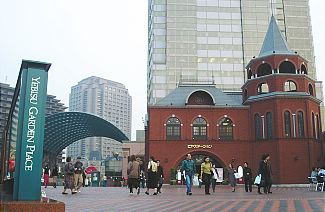
Yebisu Garden Place is one of Tokyo's most pleasant cities within the city. Consisting of roughly a dozen buildings and skyscrapers, it features a large array of restaurants and shops including a Mitsukoshi department store, the Westin Tokyo hotel, offices, residential space and two museums.
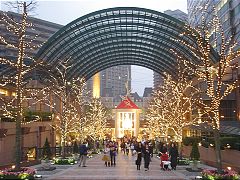 | 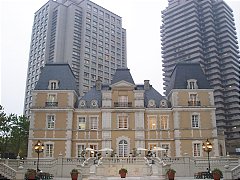 |
Yebisu Garden Place is built on the former site of a beer brewery, where the still existing Yebisu Beer brand had been brewed since 1890. Interestingly, it was the beer brand which gave the later developing town and railway station of Ebisu ("Ebisu" is the modern way to write "Yebisu", as the syllable "ye" and corresponding kana characters have almost completely disappeared from the modern Japanese language and been replaced by the "e".) its name, and not the other way around.
The Beer Museum Yebisu (entrance free) commemorates the original brewery, displays exhibits about the history and science of beer brewing in Japan and the world and offers beer tasting. After a visit to the beer museum, you may want to consider a meal and drink at the beer restaurant "Beer Station".
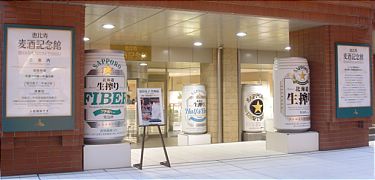
Yebisu Garden Place is a 5 minute walk from Ebisu Station on the JR Yamanote Line and JR Saikyo Line, one station south of Shibuya Station. It is connected with the station by the well marked "Yebisu Skywalk".
Ameyoko
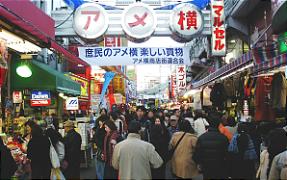
Ameyoko is a busy market street along the Yamanote line tracks between Okachimachi and Ueno Station, the site of a black market after World War Two. The name "Ameyoko" is a short form for "Ameya Yokocho" (candy store alley), as candies were traditionally sold there. Alternatively, "Ame" also stands for "America", because a lot of American products were available on the black market.
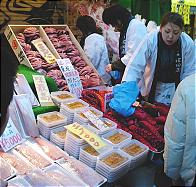 | 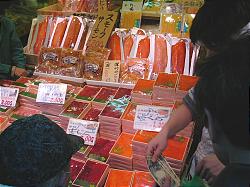 |
| Tuna, sea urchin, octopus, salmon and various fish eggs for sale | |
Today, various products such as clothes, bags, cosmetics, fresh fish, dried food and spices are sold at bargain prices along Ameyoko.
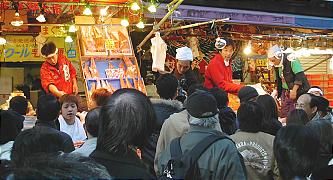
Get off at Ueno or Okachimachi Station on the JR Yamanote or JR Keihin-Tohoku Line.
Kappabashi Street
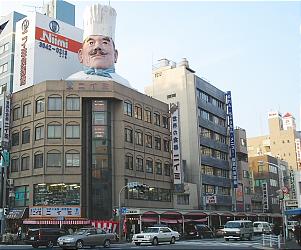
Kappabashi Street is a shopping street between Ueno and Asakusa, which is lined with several dozens of stores selling everything needed by restaurant operators, with the exception of fresh food.
You will find specialized stores for dishes, pots, pans, cooking utensils, stoves, tables, chairs, signs, lanterns and more. Not at last, there are a few stores which sell plastic and wax food samples, used by many restaurants in their show windows.
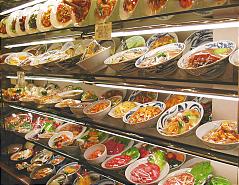 | 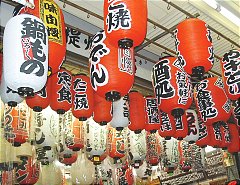 |
The closest station is Tawaramachi Station on the Subway Ginza Line.